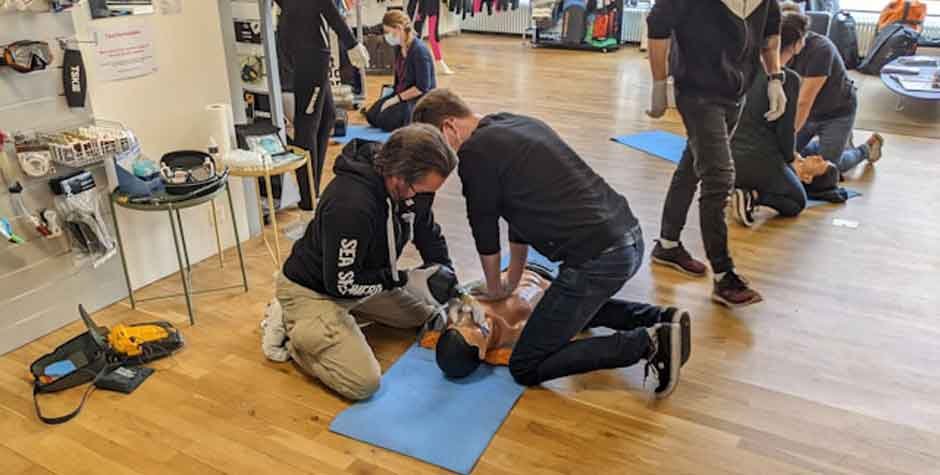Parenthood brings immense joy but also comes with the responsibility of ensuring your child’s safety. Accidents can happen, and being equipped with basic first aid knowledge is essential. Here are five crucial first-aid tips every parent should know when caring for kids.
1. Choking Hazards and the Heimlich Maneuver
The tendency of children to experiment by putting things in their mouths increases the likelihood of choking accidents. Caretakers and parents should know how to do the Heimlich technique because it allows obstructions to be quickly removed and potentially harmful situations avoided. In situations like these, it’s critical to respond quickly and boldly while stressing the significance of maintaining composure. People are better equipped to react when they know age-appropriate Heimlich maneuver procedures and are aware of typical choking threats that are suited to different developmental stages. Updating these life-saving abilities on a regular basis and remaining knowledgeable about child safety precautions help create a safe atmosphere where kids can flourish and safely explore their surroundings.
2. CPR for Infants and Children
Comprehensive knowledge of Cardiopulmonary Resuscitation (CPR) is indispensable, especially when applied to infants and young children. Pediatric CPR involves specialized techniques like chest compressions and rescue breaths, addressing the distinct needs of young individuals. Acquiring pediatric CPR training ensures a swift and efficient response to emergencies involving newborns and children, emphasizing the nuances of life-saving measures tailored to their smaller bodies. This training instills confidence and competence in navigating critical situations involving the youngest members of our community. To provide convenience and accessibility, you can easily get a CPR certification online through online courses that offer adaptable learning environments, enabling individuals to progress at their own pace. This approach proves especially beneficial for those with busy schedules, ensuring readiness to respond effectively in pediatric emergencies.
3. Treating Minor Cuts and Scrapes
Little cuts and scrapes are common in children, so it’s important to know the proper way to heal them. If you have a small cut or scrape, start by gently washing the area with water and mild soap to get rid of any debris or bacteria. Using an antiseptic ointment helps stop infection, and a sterile bandage helps the wound heal properly. Children who are taught the fundamentals of wound care and cleanliness are more likely to be independent and to know how to care for themselves in the event of a minor accident. Keeping a filled first aid kit at home is also essential for responding to such situations quickly and efficiently.
4. Recognizing Allergic Reactions
In youngsters, allergic reactions can be quite severe, so it’s important to identify symptoms as soon as possible. Watch out for symptoms like breathing problems, edema, or the emergence of skin hives. It is imperative to keep an epinephrine auto-injector on hand if your child has a known allergy. If you experience a severe allergic response, take quick action to administer the auto-injector as instructed and get emergency medical attention. Recognizing the warning signs of an allergic response and acting quickly to protect your child can save their life in emergencies. Keeping an emergency action plan in place and maintaining regular contact with medical professionals to control allergies both improve preparedness.
5. Dealing with Fever and Heat-Related Illnesses
Particularly in hot weather, children are prone to fever and heat-related disorders. Encouraging frequent water consumption is essential to keeping children hydrated and ensuring their well-being. Additionally, lowering their body temperature can be achieved by bathing them in lukewarm water or applying cool compresses to their forehead. It is essential to monitor their temperature using a reliable thermometer. It’s critical to know when to get medical help; a fever that doesn’t go down or heat exhaustion symptoms like weakness, profuse sweating, or nausea should be treated right away. It is important to pay attention to these signs and take the necessary action to ensure that children’s fever and heat-related problems are managed quickly and effectively.
Conclusion
Equipping yourself with basic first aid skills empowers parents to respond effectively in emergencies involving their children. Taking the time to learn and regularly practice these essential first-aid tips fosters confidence and preparedness, contributing to the creation of a safer environment for children to thrive. Your proactive approach to first aid ensures a swift and confident response in critical situations, promoting the well-being and safety of your family.


